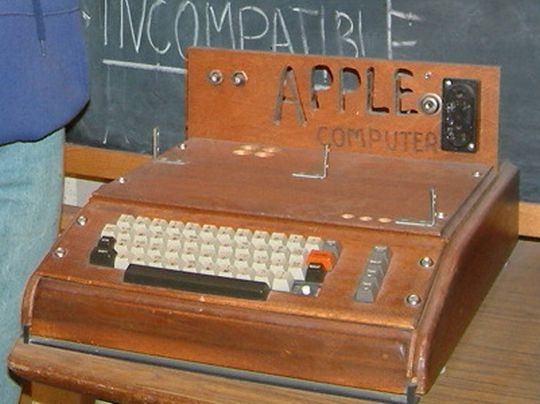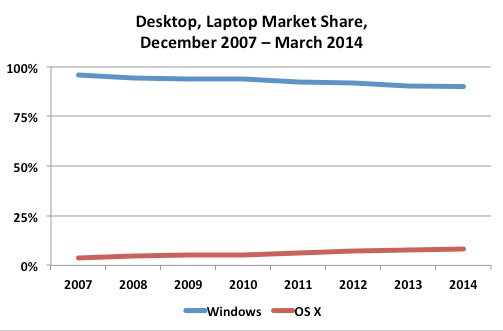Apple’s history of hits and misses – Part 1

People who admire Apple Inc. for what it has accomplished over the years tend to believe the company can do no wrong. But the idea that Apple is destined to remain at the top of the tech heap forever is, in my opinion, misleading to investors. Because, as we all know, nobody stays at the top forever.
Most myths have some basis in fact, and Apple myths probably more than most. Because Apple has obviously done well over the last 15 years or so. But myths tend to skew our perception of reality. They operate as a filter through which to view reality, and that filter tends to let us see only what we want to see.
The first Apple myth I want to look at is the idea that whenever Apple releases a product it is guaranteed to succeed. This is “The Myth of Guaranteed Success” or the MGS. An alternate title for this might be “The Myth of Apple Infallibility”. In a recent article in Seeking Alpha, one author wrote: “I believe wholeheartedly in Apple’s future, and think it could sell vast quantities of any electronic good it put its brand on” – quoted from “Could Apple Disappoint This Quarter?”, Oct. 1, 2014.
It would be hard to find a better statement of this myth, and this is not an unusual sentiment. We see this sort of faith stated every day in Seeking Alpha – a website devoted to sharing investment information. The idea is that Apple is really something special – that it is so market savvy, so in tune with the likes and dislikes of its devoted customer base, so good at beautiful design – just so darned superior in every way to all of its backward-thinking competitors – that it is impossible to even consider the possibility that it might lose its Midas touch.
Yes, recent history seems to support this. Since roughly 2000 (the modern era) Apple has had an unprecedented series of successes that have made it the largest company in the world. No question. In rapid succession, the iPod, iTunes, iPhone and iPad have been remarkably successful.
 Mac desktop/laptop market share has been slowly increasing.
Mac desktop/laptop market share has been slowly increasing.And relative to the company’s fairly lacklustre performance in the period before 2000, Mac desktops and laptops have done pretty well too, although still hovering under 10% of worldwide market share.
Pulling the Myth of Guaranteed Success Apart
Surely critical observers like you and me, and especially investors or potential investors, should ask a number of questions about this recent track record, and I will do so in this series of articles. Here are some of the more obvious questions:
1. Does Apple’s track record prior to the modern era support the Myth of Guaranteed Success?
2. Was there some significant change in Apple’s management or product philosophy that accounts for the recent string of successes?
3. Were there significant external factors – for example, changes in the tech environment – that Apple was able to exploit that help to account for its success in the modern era?
4. Is the tech environment changing again in significant ways? And if so, will the reasons for Apple’s success in the modern era still apply to a changing landscape?
5. Is the existence of the Apple customer base and “ecosystem” enough to counter the lack of low hanging fruit?
I think you can see where I am going with these questions. I am going to argue that first, Apple was not wildly successful until the current era (roughly 2000 to the present). That is hardly open to question since as recently as 1996 Apple was on the verge of bankruptcy.
Second, I am going to suggest that Apple’s success in the current era was at least partially due to luck, or, more charitably, good timing. It has been the result of very cleverly exploiting certain aspects of the tech environment, and taking advantage of “low hanging fruit”.
And thirdly I will argue the obvious point that the tech environment is changing. Conditions that led to continued success are rapidly changing, and formulas that worked in the past are not guaranteed to work in the future. “Low hanging fruit” opportunities are much harder to find these days, as demonstrated by Apple’s halting moves into wearables (Apple Watch) and digital payments (Apple Pay).
1. Apple’s Historical Track Record
For a more detailed overview of Apple’s product history you can find the appropriate Wikipedia articles, or any number of online sources. For this article I will just do a quick summary. No doubt many of you are familiar with the details.
We can break Apple’s corporate history down into three fairly distinct periods. The Early Years (1976-1985), The Middle Years (1985-1997), and The Current Era (roughly 1998 to the present). These periods essentially correspond to the active involvement of Steve Jobs in the company. The Early Years could be called Steve Jobs I, the Middle Years, without Steve Jobs, and the Current Era, Steve Jobs II (and beyond).
The Early Years (1976-1985) started with the introduction of the Apple I, II, and III, and came to a close with the introduction of the Macintosh, along with the ouster of Steve Jobs because of internal struggles and mediocre sales. The important points to note are that while it is true that the Macintosh was a product of Jobs’ flair for somewhat out-of-the-box thinking, and began to develop a loyal group of followers, the Macintosh did not do all that well in terms of sales.
The Mac was, however, able to carve out a niche among graphic designers, publishers and artists, and made some inroads into entertainment and education, but never posed a serious threat to the Wintel juggernaut, and never gained much of a foothold in business. Apple computers were also generally more expensive than the alternatives, and so were not widely popular with consumers either.
The Middle Years (1985-1997) were marked by significant unrest and instability at Apple. By the early 90s the Mac platform was running out of gas and Apple’s leaders were looking for alternatives. A lot of time, energy and money was spent on the search for a more powerful OS to replace the then under-powered MacOS, the development of more powerful business-oriented computers, and lots of experimentation on consumer gadgets like digital cameras, video consoles, and most spectacularly, the failed Newton – a personal digital assistant.
 Mac desktop/laptop market share has been slowly increasing.
Mac desktop/laptop market share has been slowly increasing.In any case, Apple’s fortunes went from bad to worse. Revenues in the 1996-1998 period plunged by more than 50%. Eventually in 1996-97 a sequence of events led to the reinstatement of Jobs as CEO, and a fruitful truce with Microsoft which included a significant investment. By 2001 Apple got its act together, turned things around, and became profitable again.
The Current Era (roughly 1998 to the present) began when Steve Jobs returned in 1997. By 2001 the Mac OS X (based on Jobs’ NextStep) had been developed, the first Apple Retail Stores had been opened, and the iPod digital audio player was introduced. This last item was phenomenally successful and was without a doubt the product that turned Apple around.
A string of new desktop and laptop computers were also released in the early 2000s – the translucent multi-coloured iMac G3,the Powerbook, the MacBook Pro and eventually the iMac. But more importantly the iPod was followed up by the development of the iTunes online digital music store in 2003 and the development of iOS, the UNIX-based operating system subsequently used on the iPhone, iPod Touch and iPad. The iPhone and iPod Touch were introduced in 2007, and the iPad in 2010. All three have been game changers, market leaders and phenomenally profitable.
Focusing on these new products was clearly an attempt by Apple to diversify in the light of projections that the times were rapidly changing and the Mac had limited growth potential. None of the products before the iPod were strikingly successful. What is consistent is a focus on the consumer market, the inability to crack into enterprise in a serious way, and most importantly, the breakthrough iPod that led directly to iTunes, iPod Touch, iPhone and iPad.
2. Factors leading to Apple’s success in the Current Era
By 1996 Apple was on the brink of bankruptcy. What factors changed that led to Apple’s current success?
First and foremost, Jobs returned and instituted a more focused approach to the market. That included settling old non-productive squabbles with Microsoft, and getting the software behemoth to help promote mainstream applications (Like Office and Internet Explorer) on the Mac.
The development and experimentation done in the middle (non-Jobs) period also was put behind them and actually began to pay off. Nevertheless, it is clear that the Mac was never going to make Apple the world’s largest company. Even by 2006, in spite of increased success, Macintosh computers still only accounted for about 8% of all desktop and laptop computers.
Jobs gets a lot of credit for Apple’s success, but clearly the success of the iPod was, to a large extent, due to good timing and a fair bit of luck. The entertainment industry was being revolutionized as physical media (records, tapes, CDs, DVDs) were being replaced by downloadable digital media. This shift was just part of the “computerization” of industry that began in the 60s and 70s and is still ongoing today.
There was clearly a market for portable audio listening devices. Sony had already successfully tapped into the portable audio market with the Walkman, and before that other products like the “transistor radio” had made a splash. The iPod was the inevitable product of the evolution of these products, made possible by the digitizing of music and the development of the internet.
Near the turn of the century iTunes was developed in direct response to the popularity of peer-to-peer music sharing sites like Napster. When Napster was declared illegal in 2001 what followed was a gradual acceptance of the fact that online music was inevitably going to cease being a free-for-all.
iTunes was Apple’s solution to the chaos of digital music downloads It was obviously the best, most comprehensive solution and by 2006 had captured almost 90% of the market. This market share has been slowly going down as other major players (like Google) have entered the market. The bottom line is that the combination of iPod and iTunes came along at precisely the right time to capitalize on what was essentially low hanging fruit.
Is it likely that Apple would have the opportunity to exploit another situation like this? Well, surprise surprise! It happened again with the iPhone just a few years later.



